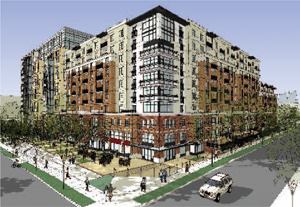NEW CHALLENGES Dealing with the federal government was one thing. Dealing with the city was a different ball game. Cohen attended countless planning meetings to get what he originally wanted: 650,000 square feet of office space and a 200-unit apartment building.
But as the New York Avenue metro came in and plans for other office buildings, such as the headquarters for The Bureau of Alcohol, Tobacco, Firearms, and Explosives (ATF), took shape, Cohen changed course. “I read the market as not being able to absorb 650,000 square feet,” Cohen says. “I started from scratch. I went from [all of that] office space to all multifamily residential.”
Of course, the residents with the seven parcels he hadn’t closed on also knew about the ongoing development. When he finally did close with them, he paid twice the originally negotiated price. “The last properties were more difficult,” he says. “People were a little more unrealistic as to what they wanted.”
As Cohen approached the finish line on the project in early 2007, the country was about to stumble into the recent financial crisis—one that many people compare to the RTC turmoil in the early ’90s.
This problem has been an issue for builders in NoMa. “Some projects are slower to get started than they maybe hoped because financing is taking longer than people had originally penciled in,” Price says. “But we haven’t had any projects pulled.”
Cohen soon enlisted the help of the Washington, D.C., office of New York City-based The Greenwich Group International. That led to a connection with Westdeutsche ImmobilienBank AG in Germany, which helped bring in pension fund TIAA-CREF as a financial partner. “We weren’t even looking for a partner,” Cohen says. “[But] they were excited. They latched onto this property, and they wanted to do a joint venture.”
Even though he got through the financing process, Cohen acknowledges that he’s not certain what the market will look like in late 2009 when the 212 rental units in Union Place’s first phase, called The Loree Grand, are delivered. Since the project is one of the few rentals in an area with high home prices, Michael Sims, a longtime D.C. broker and managing director for Sperry Van Ness, a brokerage firm based in Irvine, Calif., is confident it will do well. “I think it has great potential,” he says. “It’s in an underserved area for luxury, high-end apartments.”
Cohen sees this as well. “You start looking at sale figures of [nearby] Union Station, and you realize there is real swelling,” he says. And it’s that sales pace, not the credit crunch, that is keeping Cohen in a holding pattern with the development’s second phase, which would add about 580 rental units to the market.
But long term, Cohen is bullish on the market. “I’m the eternal optimist,” Cohen says. “I think the market will correct itself. If all of these offices in the area fill up, then we’ll see a groundswell of need.”
Price sees that potential as well, especially with the project’s proximity to Capitol Hill. “There isn’t a lot of [high-rise] product in and around him,” Price says. “NoMa has nothing right now. For people who like that lifestyle, there are very few opportunities. That will be helpful for them in leasing up.”
Eventually, with ATF and other office buildings in the area, Sims thinks demand in the NoMa area will grow. The new metro won’t hurt, either. “The price of fuel has made more people urbanites,” Sims says.
ACTION ITEMS
TAKING ACTION
Even if you don’t have 20 years to get a deal done, these tips can help you turn complex projects into reality.
Be nimble. As a neighborhood evolves, development opportunities may change. Originally, Ron Cohen of Rockville, Md.-based The Cohen Cos got approvals for a 200-unit apartment building and 650,000 square feet of office space. But that changed. “In 1998 and 1999, I realized there was great need for multifamily,” Cohen says.
- Be attentive. Cohen won credibility with the municipality and neighborhood groups by going to planning meetings and staying until late into the night. “I would listen to people,” Cohen says.
- Complete the neighborhood. To assemble a full city block for development, Cohen had to enter an emerging area. To bring others along, he needed to offer neighborhood amenities. “You go into a fringe area and hope somebody [will] want to live there,” he says.
